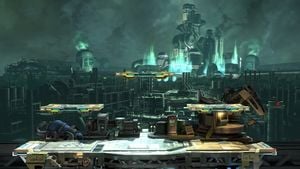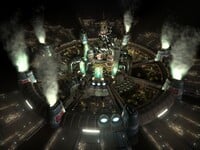Midgar
| Midgar | |
|---|---|
 Midgar in Super Smash Bros. for Wii U. 
| |
| Universe | Final Fantasy |
| Appears in | SSB4 |
| Availability | Downloadable |
| Crate type | Normal |
| Maximum players | 8 |
| Tracks available | Let the Battles Begin! Fight On! (Alternate in 3DS) |
Midgar (ミッドガル, Midgar) is a Final Fantasy stage in Super Smash Bros. 4 which is available as downloadable content, as part of a set with Cloud.
Stage layout
The basic layout of the stage is very simple, similar to Battlefield though larger. However, occasionally Summon Materia float around the stage: when touched by a character they make a summoned monster appear with greatly disruptive effects on the battle:
- Odin: Cuts right through the stage's center with his sword causing the stage to split similar to Brinstar. Anyone sliced by it will be OHKO'd. Characters caught by the stage coming back together are OHKOed by crushing. Resembles Zantetsuken.
- Leviathan: Floods the arena, making the main platform surf across a huge body of water. Fighters who fall to the right of the stage will be swept into the side of it, taking 9% damage. This will also affect the summoner. Resembles Tsunami.
- Ramuh: Electrifies the three floating platforms. Resembles Judgment Bolt.
- Ifrit: Makes a huge flame erupt under the right side of the stage, tilting it to the side. Resembles Hellfire.
- Bahamut ZERO: Attacks with a devastating Teraflare, which destroys the city in the background and creates a damaging pillar of light on the stage.
Origin
Midgar is the the first area visited in Final Fantasy VII and is the location for much of the game's beginning. Midgar is the capital city and power base of the Shinra Electric Power Company. The city is divided up into nine sectors. In SSB4, the stage appears to take place on Midgar's top plates, above the ground-level slums that were commonly explored in the original game.
Midgar was built by the Shinra Electric Power Company, lead by President Shinra, the descendant of a boy named Shinra from the world of Spira[1], the setting of Final Fantasy X and its sequel.
The Shinra Building, one of the most iconic locations in Final Fantasy VII, is visible in the background. A prominent dungeon within the game, it is the headquarters for the Shinra company which plays a central role in FFVII's storyline. The building is where Cloud meets Red XIII, a sentient animal from Cosmo Canyon and later discovers that Sephiroth killed President Shinra, making the President's son Rufus the new president. After Sephiroth summons Meteor, Rufus makes plans to attatch a cannon to the building and siphon energy from the seven standing Mako Reactors. While this is going on, Hojo, one of Shinra's top scientists attempts to make the cannon blast the Northern Crater to empower his "son," but is stopped by Cloud's team.
By the end of FFVII, Midgar is nothing more than the skeleton of what it once was, with the town of Edge springing up around it. It soon becomes the epicenter of the disease known as Geostigma, created by Jenova cells infecting the Lifestream. The Remnants of Sephiroth attack Cloud, Tifa, and their adoptive family. Kadaj, the leader, eventually summons Bahamut SIN to stall Cloud's friends, while Cloud battles him alone in the ruins of Midgar, and again fighting Sephiroth.
It is shown that 500 years after the events of the FFVII storyline that the once infertile land surrounding Midgar would be seen by Red XIII, his cubs, and potentially Vincent Valentine, now overtaken by plate techtonics and the rapid growth of nature, although it is still habitable.
Summons have been a recurring element in the Final Fantasy series since their introduction in Final Fantasy III. They are powerful creatures which can be summoned into battle to attack enemies or support the party. In Final Fantasy VII they can be summoned by equipping specific Materia: all the summons appearing on this stage are also available in the source game.
- Odin, introduced in Final Fantasy III, attacks with his sword, Zantetsuken, with a chance to cause instant death. In some games enemies immune to instant death receive heavy non-elemental damage instead.
- Leviathan, introduced in Final Fantasy II but available as a summon starting with Final Fantasy III, attacks with Tidal Wave, which deals Water damage.
- Ramuh, introduced in Final Fantasy III, attacks with Judgment Bolt, which deals Lightning damage.
- Ifrit, introduced in Final Fantasy III, attacks with Hellfire, which deals Fire damage.
- Bahamut, introduced in the first Final Fantasy and available as a summon since Final Fantasy III, attacks with Mega Flare, which deals non-elemental damage. Several variations of Bahamut exists, whose attack are often more powerful variations of Mega Flare: Bahamut ZERO, introduced in Final Fantasy VII, uses Tera Flare.
Gallery
Midgar in Super Smash Bros. for Nintendo 3DS.
Trivia
- Midgar is the first stage in the series that originates from a game that has never been released on a Nintendo system in any form.
- Midgar appears as a stage in Dissidia Final Fantasy, making it one of five stages in the Super Smash Bros. series to be featured as a stage in other fighting games, with the others being the Boxing Ring, Pyrosphere, Green Hill Zone, and Suzaku Castle.
- Midgar is the only stage on both versions to have the exact same songs in both versions.
- This distinction makes it the stage with the fewest music tracks in the Wii U version, having only two.
References
- ^ http://uk.faqs.ign.com/articles/702/702971p1.html Final Fantasy X-2 Ultimania FAQ
External links
- Article on the Final Fantasy Wiki
|
| |
|---|---|
| Fighters | Cloud (SSB4 · SSBU) · Sephiroth (SSBU) |
| Stages | Midgar · Northern Cave |
| Other | Aerith Gainsborough · Bahamut ZERO · Barret Wallace · Chocobo · Ifrit · Leviathan · Odin · Ramuh · Tifa Lockhart |
| Trophies & Spirits | Trophies · Spirits |
| Music | SSB4 · Ultimate |
| Related universe | Kingdom Hearts |






